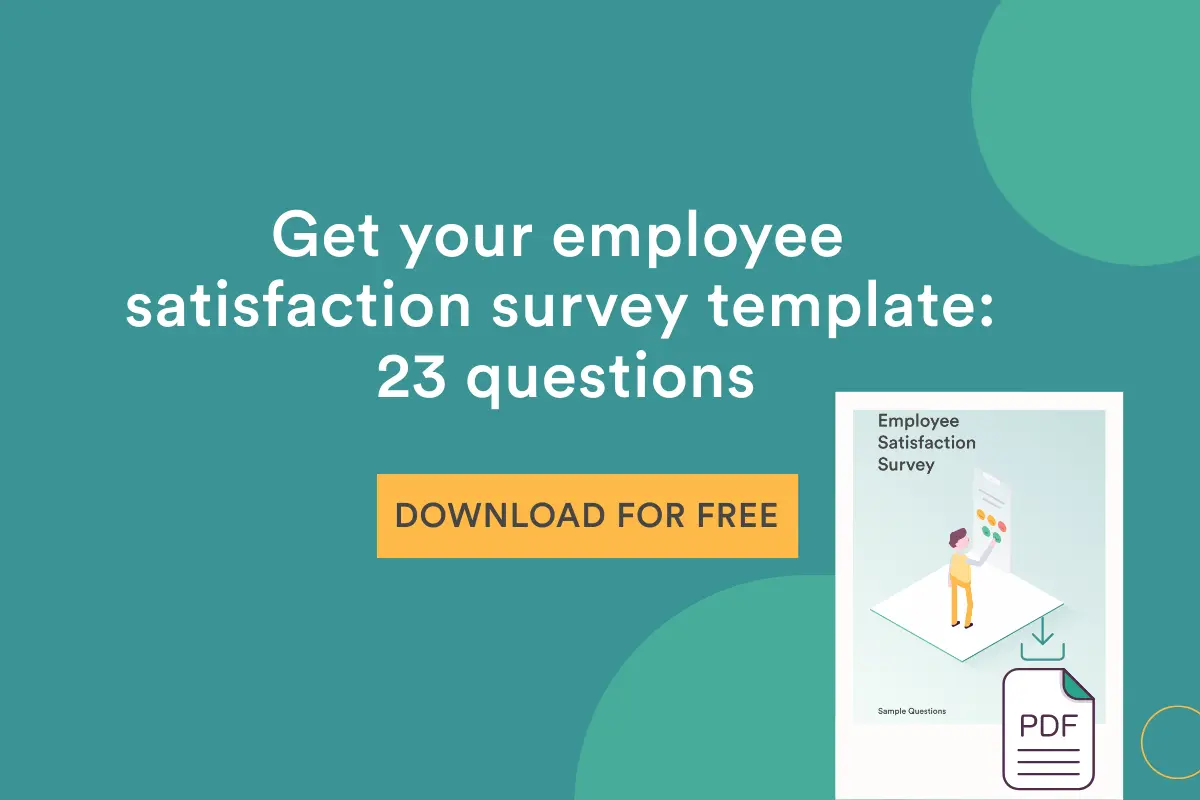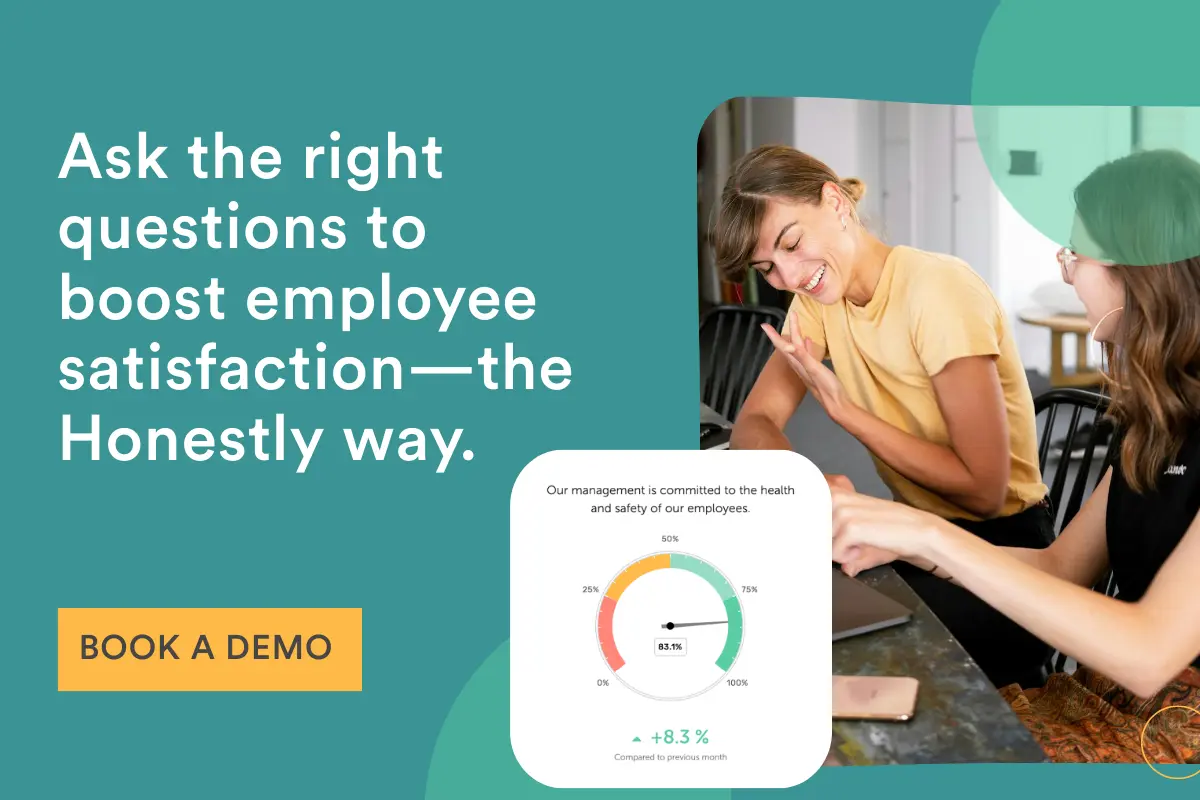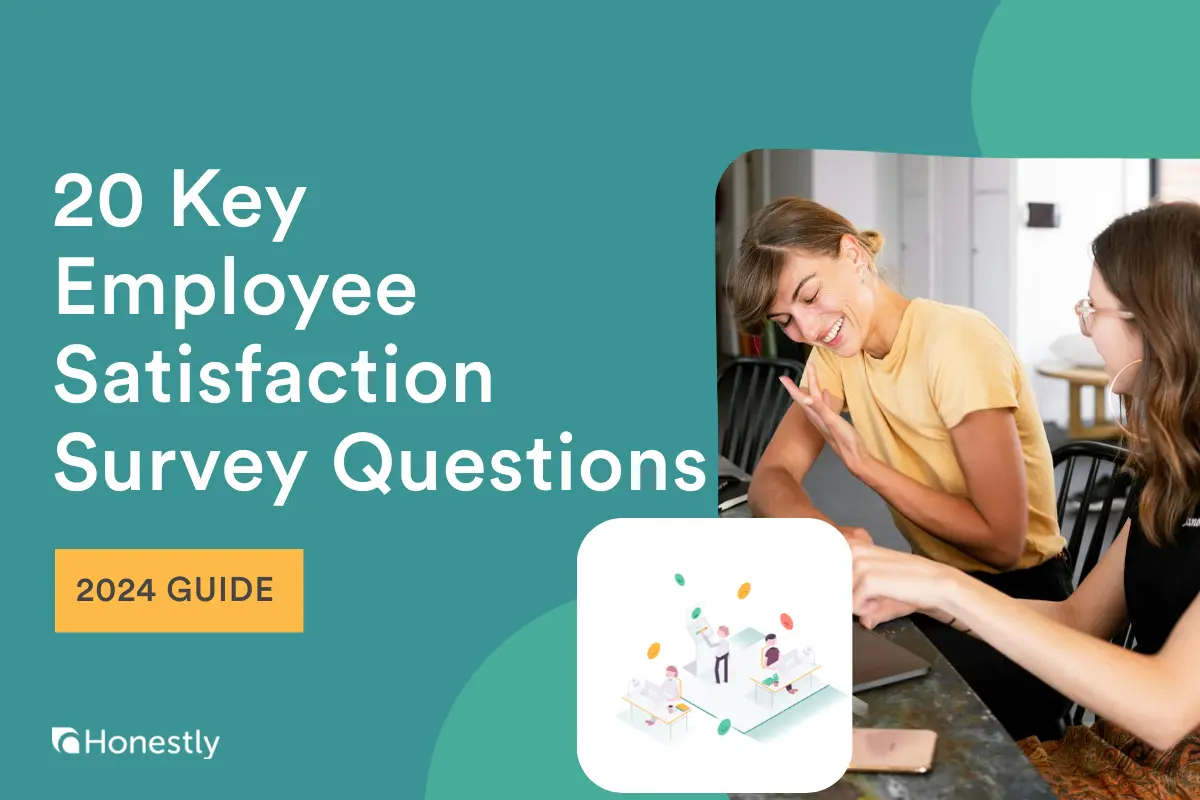
Struggling with disengaged employees and high turnover?
Employee satisfaction surveys might just be the game-changer you’re looking for.
They offer a direct line into your team’s thoughts and feelings, cultivating a high-performing work environment.
This guide will explore the ins and outs of employee satisfaction, how to effectively measure it with surveys, and the steps to take afterward.
We’ll also share the top 20 employee engagement survey questions to ask in 2024.
Use our free template to follow along.
What Is Employee Satisfaction
Employee satisfaction measures how happy and supported your employees feel in their jobs and workplace.
It includes their feelings about their role, work environment, the appreciation they receive, and growth opportunities.
This metric directly impacts retention rates, team morale, and overall productivity—all vital for the long-term success of your business.
Employee Satisfaction vs. Employee Engagement
Employee satisfaction and engagement are related, yet they focus on different aspects of the workplace experience.
Satisfaction covers how content employees are with their jobs, including pay, environment, and work-life balance.
Engagement, on the other hand, measures how emotionally invested employees are in their work and the company’s goals.
It’s best to measure both metrics to keep your teams happy and motivated.
Why Do You Need Employee Satisfaction Surveys?
Measuring employee satisfaction helps you build motivated and high-performing teams.
Why?
Because satisfied employees are 31% more productive and are much more likely to care about their company.
Employee satisfaction surveys can truly make a difference. They:
- Pinpoint what boosts job satisfaction, triggering efficient improvements.
- Open a safe channel for employee feedback, making sure every voice is heard.
- Offer valuable data on the company’s well-being, aiding strategic planning.
- Enhance transparency around the company’s future plans, reducing anxiety and stress among your workers.
So, it’s a straightforward, data-driven approach to maximizing your employees’ potential.
The Top 20 Employee Satisfaction Survey Questions
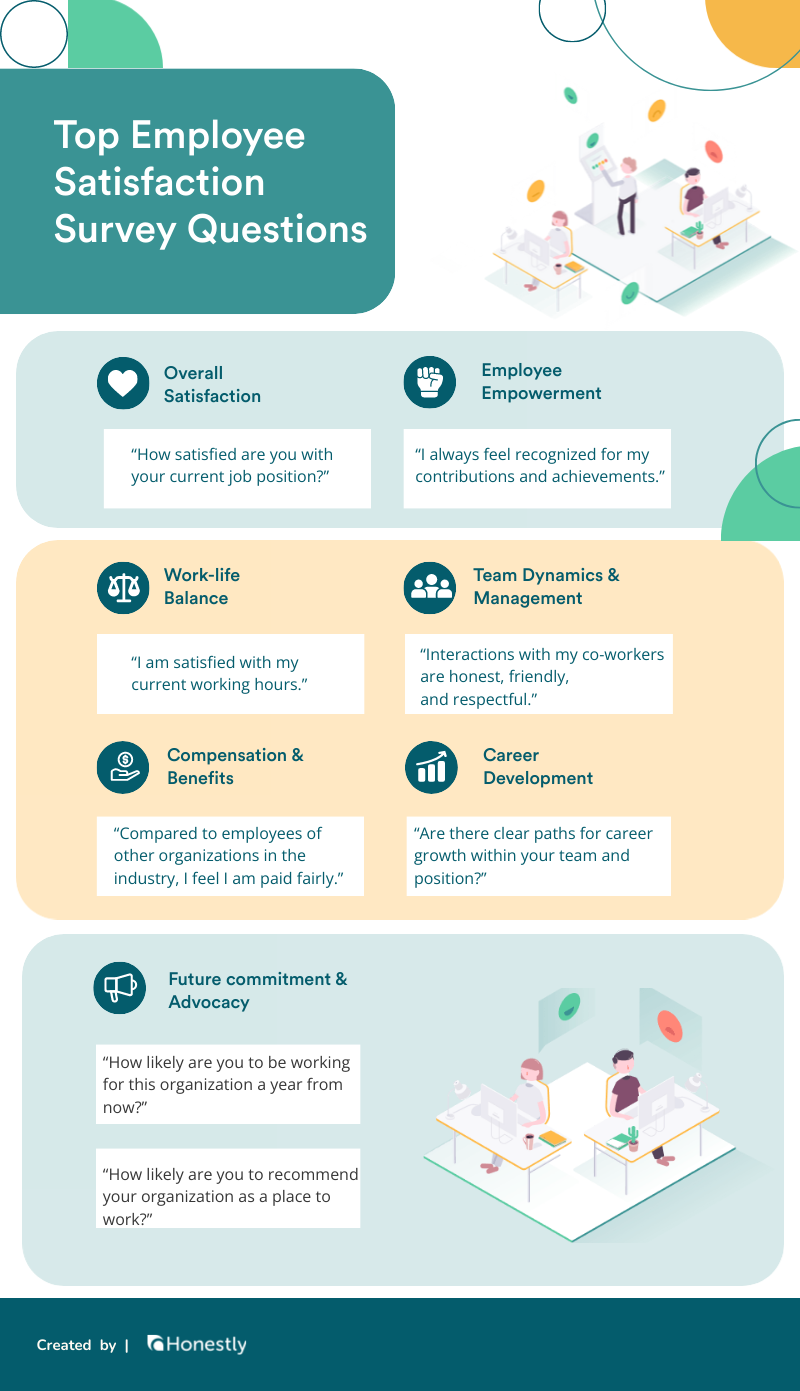
Crafting the perfect employee satisfaction survey requires a tailored approach to reflect your company’s current needs.
Yet, adding a few of the best, proven questions will give you a head start. For example, PARI GmbH achieved an impressive 80% survey participation rate by combining Honestly’s templates with custom questions.
We’ve put a selection of must-have employee survey questions you can use right away.
Survey Questions About Overall Employee Satisfaction
Kick off your survey with questions about the overall work environment to understand how your team feels on a larger scale.
1. How satisfied are you with your current job position?
This question uncovers how individuals feel about their daily work and responsibilities.
It can highlight roles or areas within the company where satisfaction is low, guiding you to implement necessary changes.
For example, you might see that people in certain positions or departments have lower satisfaction levels than their peers.
In this case, you can use the “Likert scale” survey question type with a series of emoticons.
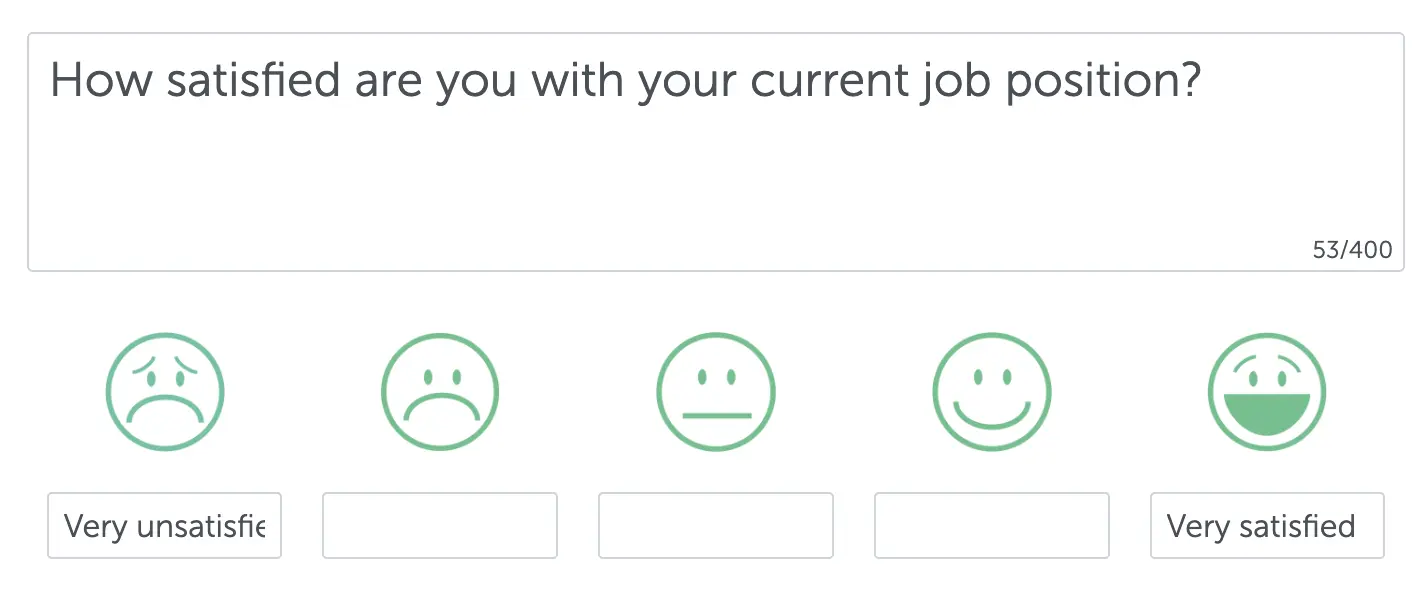
2. How satisfied are you with the organization as a whole?
This question helps you understand how your employees view the company culture and if they feel aligned with its values and objectives.
You can then use follow-up questions to clarify specific problems that impact their commitment and retention.
Questions About Employee Empowerment
Your employees need to know they make a real impact in their organization.
The next set of questions lets you uncover how they perceive their roles and influence in your company.
3. My skills and abilities find use in my job position.
Asking this question helps you align employee roles to their skills and assess the effectiveness of the current team structure.
Here, opt for a more traditional Likert scale using percentages to quantify the levels of agreement with a statement.
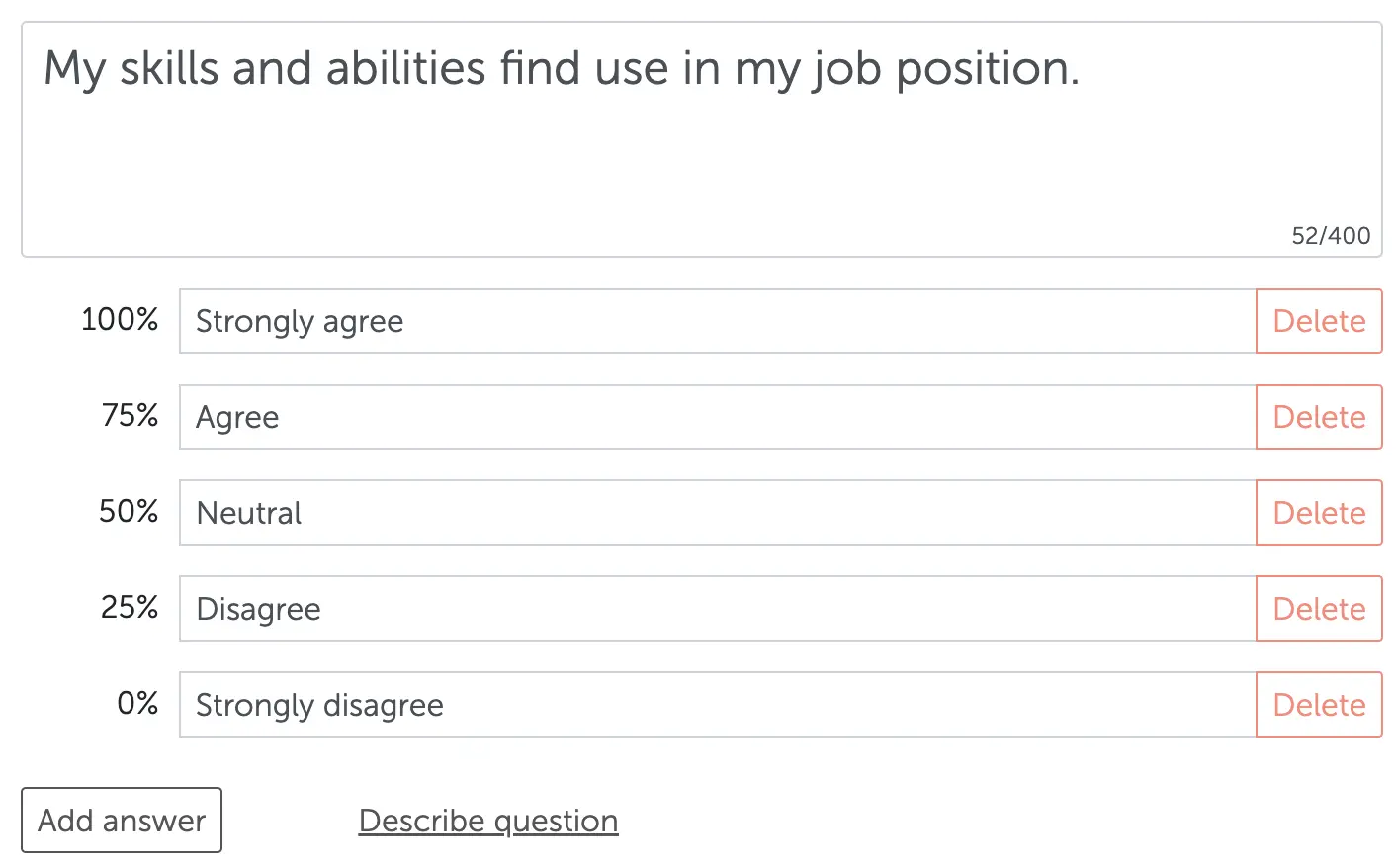
4. I always feel recognized for my contributions and achievements.
Celebrating success leads to more success.
Make sure your workers feel motivated to perform well and get the recognition they deserve.
5. I have enough authority to make the decisions I need to make.
This question reveals areas where increasing decision-making authority could boost employee satisfaction.
For instance, you might spot frustration related to micro-management and set up training for the company’s leadership.
⚡Pro tip:
Add open-ended questions for participants selecting negative responses such as “Disagree” or “Strongly Disagree” on standard survey items. This approach helps you figure out the specific issues your employees are going through.
Do you feel like analyzing so much text is a hassle?
Not if you use survey tools like Honestly! It analyzes all open-ended questions in your survey and generates comprehensive AI summaries.
Questions About Work-Life Balance
Getting work-life balance right helps you keep burnout at bay and reduce employee churn.
Use these questions to see if work demands are tipping the scales, guiding you towards a more balanced approach.
6. I am satisfied with my current working hours.
Insights from this question help you create a more flexible and satisfying workplace—for example, by introducing hybrid work or reducing the number of meetings.
7. My workload is manageable.
Asking this allows you to adjust assignments and expectations, making sure your employees don’t feel overwhelmed and burned out.
8. I regularly have to do job-related work in my free time.
It’s essential that your team members have enough time to unwind away from work.
Identifying cases of work impacting personal time helps you create a healthier work environment and reduce stress levels.
9. Do you feel you can take time off when you need to?
This question evaluates whether you have flexible paid leave policies and their impact on employee stress levels.
Questions About Team Dynamics and Management
Understanding team dynamics and leadership perceptions is key to boosting morale and creating a more collaborative culture.
10. Interactions with my co-workers are honest, friendly, and respectful.
Assessing the nature of coworker interactions shows you how to improve collaboration in your teams.
For example, a fully remote company might realize the need for in-person company retreats to get people together.
11. How realistic are your supervisor’s expectations?
This question shows whether your employees feel supported and secure.
Continuously dealing with unrealistic demands can undermine team morale and lead to burnout.
12. My direct supervisor gives me a lot of freedom in deciding how my work should be done.
Analyzing if there’s enough autonomy helps you enhance trust and innovation in task management.
13. Do you feel your input is valued in team decisions?
Valuing employee opinions ensures everyone contributes their best ideas. Make sure they feel motivated and secure enough to speak up.
Questions About Compensation and Benefits
Compensation and benefits are both essential for employee satisfaction. As simple as that—workers with higher income report greater job satisfaction.
And, it’s essential to keep your remuneration packages competitive (and not just say so in the job description).
14. Compared to employees of other organizations in the industry, I feel I am paid fairly.
Whether your employees are content with their salaries can have a direct impact on workplace churn and motivation levels.
15. How satisfied are you with the employee benefits your organization offers?
Asking this question helps tailor your benefit packages to better suit employee preferences.
For example, you might discover that your workers value access to a gym membership way more than, say, having a new foosball table in the break room.
Questions About Career Development
Are there clear paths for advancement within your company?
Employees who see opportunities for promotion and career growth are much more likely to stay and perform better.
16. Are there clear paths for career growth within your team and position?
Make sure your workers have a solid vision of their future career development in your company.
If you spot potential problems, consider reviewing the current hierarchy and introducing internal leadership programs.
17. Are you satisfied with our current policies for salary and performance reviews?
Asking this question can shed light on potential bottlenecks in your current appraisal system.
For example, some companies go on for years without performance reviews and salary increases, leading to low employee satisfaction.
Questions About Future Commitment and Advocacy
The last set of questions analyzes the long-term intentions and external perceptions of your employees.
Understanding and improving these aspects can boost employee loyalty and grow your company’s reputation as a great place to work.
18. How likely are you to be working for this organization a year from now?
This question evaluates long-term commitment, serving as an early indicator of potential employee retention issues.
19. How likely are you to recommend your organization as a place to work?
Think of this as a net promoter score (NPS) for your workplace. eNPS measures whether your team members are happy and engaged enough to vouch for the company.
20. If you could change one thing in our company, what would it be?
This question is a straightforward way to gather actionable insights and fresh perspectives on enhancing the workplace.
Who knows? Maybe it’ll reveal some truly innovative suggestions.
How to Plan and Build an Employee Satisfaction Survey
The key to success? Creating a solid strategy and an action plan behind your employee satisfaction survey. Let’s see how you can do it.
Step 1: Define The Survey Objectives and Scope
Start by deciding what you’re aiming to discover with your research.
It might be tempting to cover every inch of workplace satisfaction in one go.
But, sometimes, it’s best to focus on specific areas like work-life balance or compensation to make your survey more meaningful.
For example, if recent events suggest deteriorating team dynamics, use your survey to dig deeper into this area. Questions about management, leadership, and the overall atmosphere in the workplace could be useful.
This way you make the feedback you receive directly actionable and add improvements where they’re needed most.
Step 2: Design Your Survey Questions
Next, write down questions that will help you achieve your survey goals.
Make sure they are easy to understand and complete.
It’s also best to avoid adding questions that make your employees uncomfortable and create ambiguity. For example:
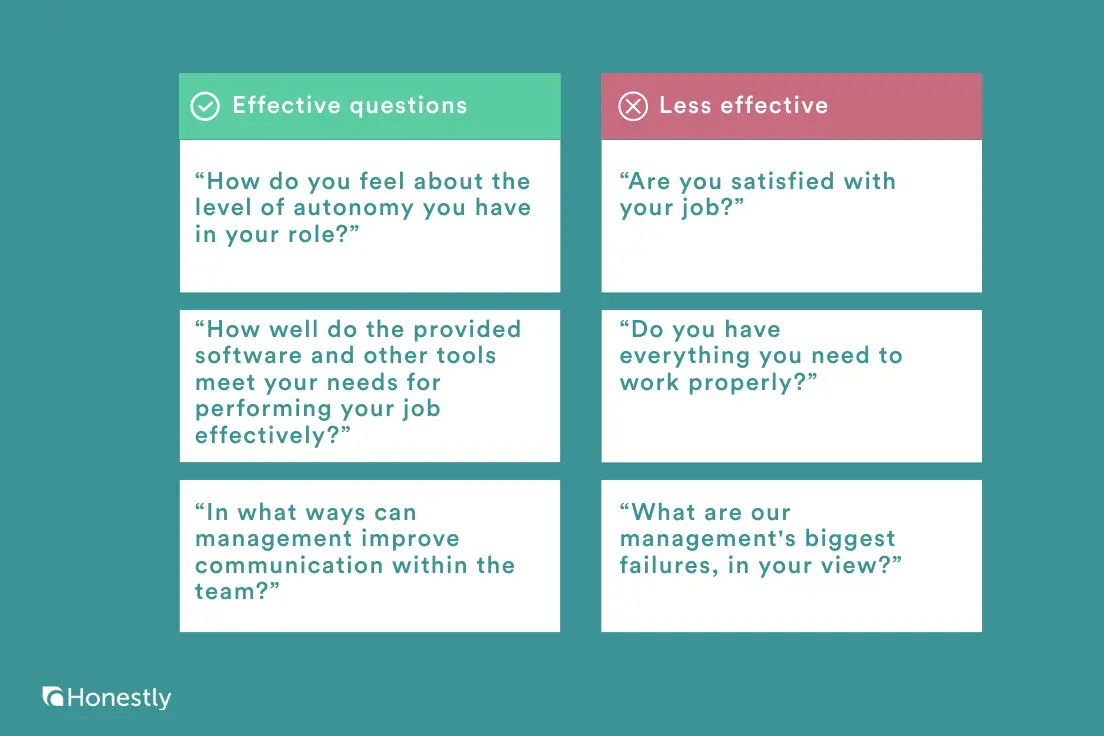
It’s also a good idea to mix different types of questions, such as:
- Open-ended questions for detailed feedback:

- Likert scales, or multiple-choice for quick insights:

- The employee net promoter (eNPS) - type questions:
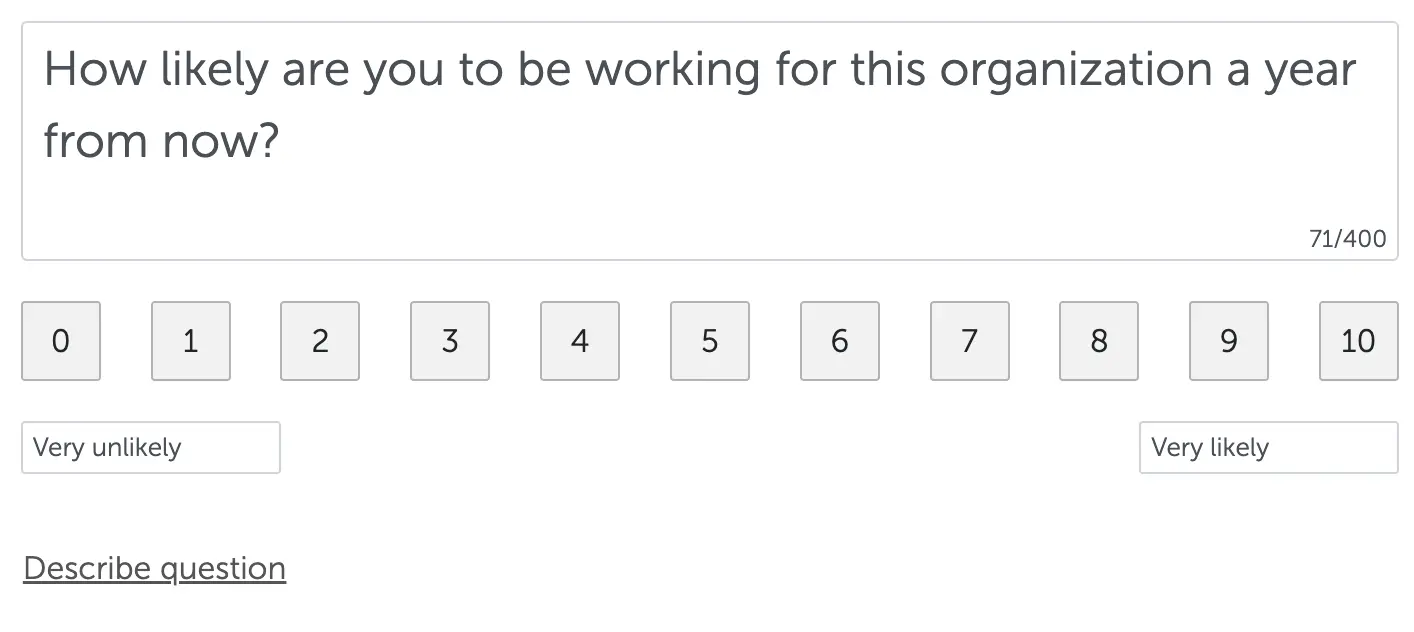
Make sure to provide clear instructions for each question type—especially for scales.
Finally, keep your employee survey questions direct and free from bias so that the feedback you receive is genuine and useful. For example:
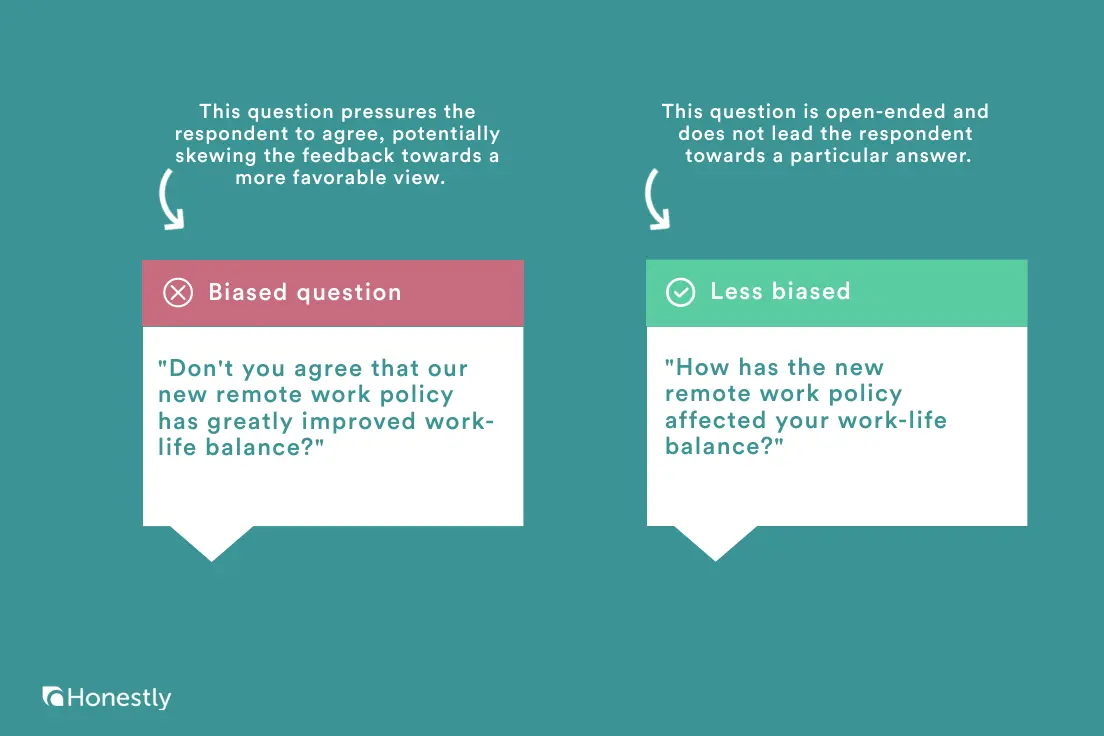
Not sure where to start?
You can use pre-created employee survey templates like those offered by Honestly. Science-based (and two of them developed together with Freie Universität in Berlin), they help you ask the right questions the right way.
To use it, simply choose the survey type and get your questionnaire ready in an instant.
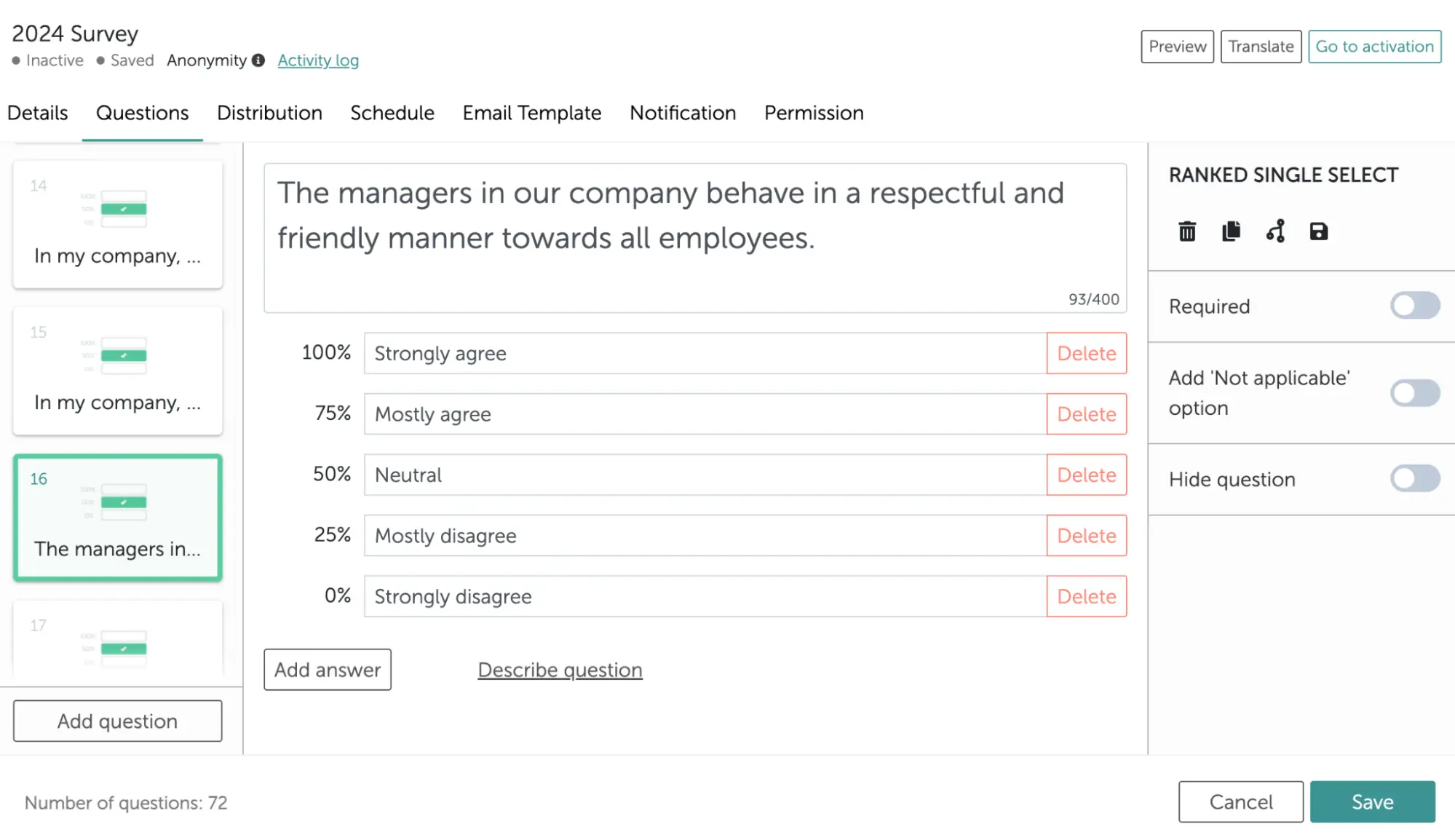
You can then add any changes and customize it the way you want.
Step 3: Choose the Survey Platform
The next crucial step is selecting the right survey platform and setting up your questionnaire.
Look for a survey tool that’s intuitive for both the creator and the respondents. Key features to assess include:
- Anonymity options: To ensure honest feedback, choose a platform that can guarantee the anonymity of responses (e.g., even if you download the responses)
- User-friendly design: Your survey tool should be easy to navigate for you and your employees.You should also be able to use it without extra IT support.
- Robust analytics tools: It should also have powerful built-in analytics—because the success of your survey ultimately depends on whether you can spot useful insights.
It’s best to look for a tool tailored to the specific needs of HR specialists and business executives.
Many generic survey tools lack templates and analytics you need to execute a successful employee survey.
For example, Honestly’s unlimited dashboards let you analyze, compare, and benchmark your survey results with ease.
You can also show different reports to different users—for example, providing team-specific statistics to team leaders and sharing broader insights with the HR team.
And, if you want to download the survey results, all responses will remain anonymous.
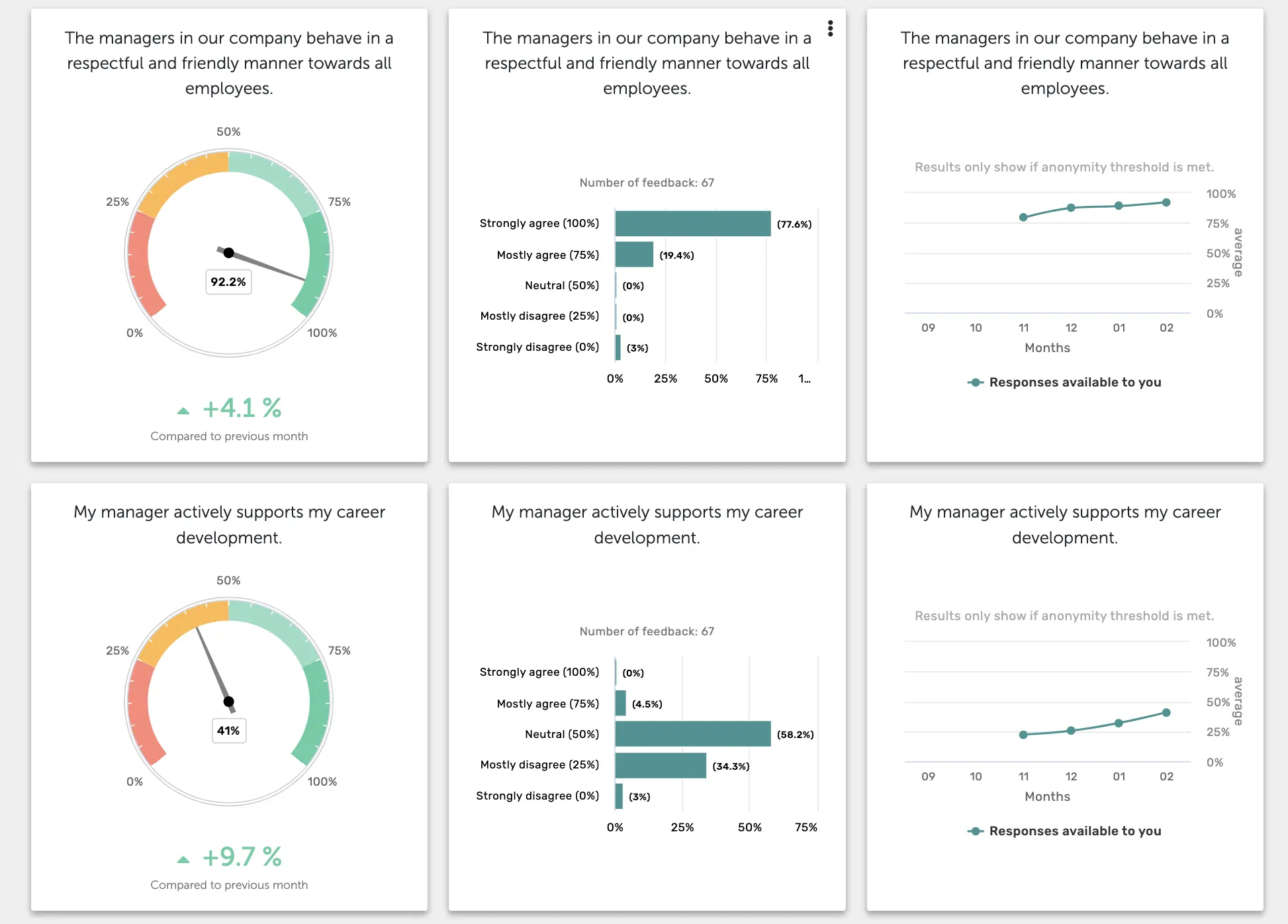
The tool’s powerful AI will also analyze all open-ended questions in your survey and generate in-depth summaries.
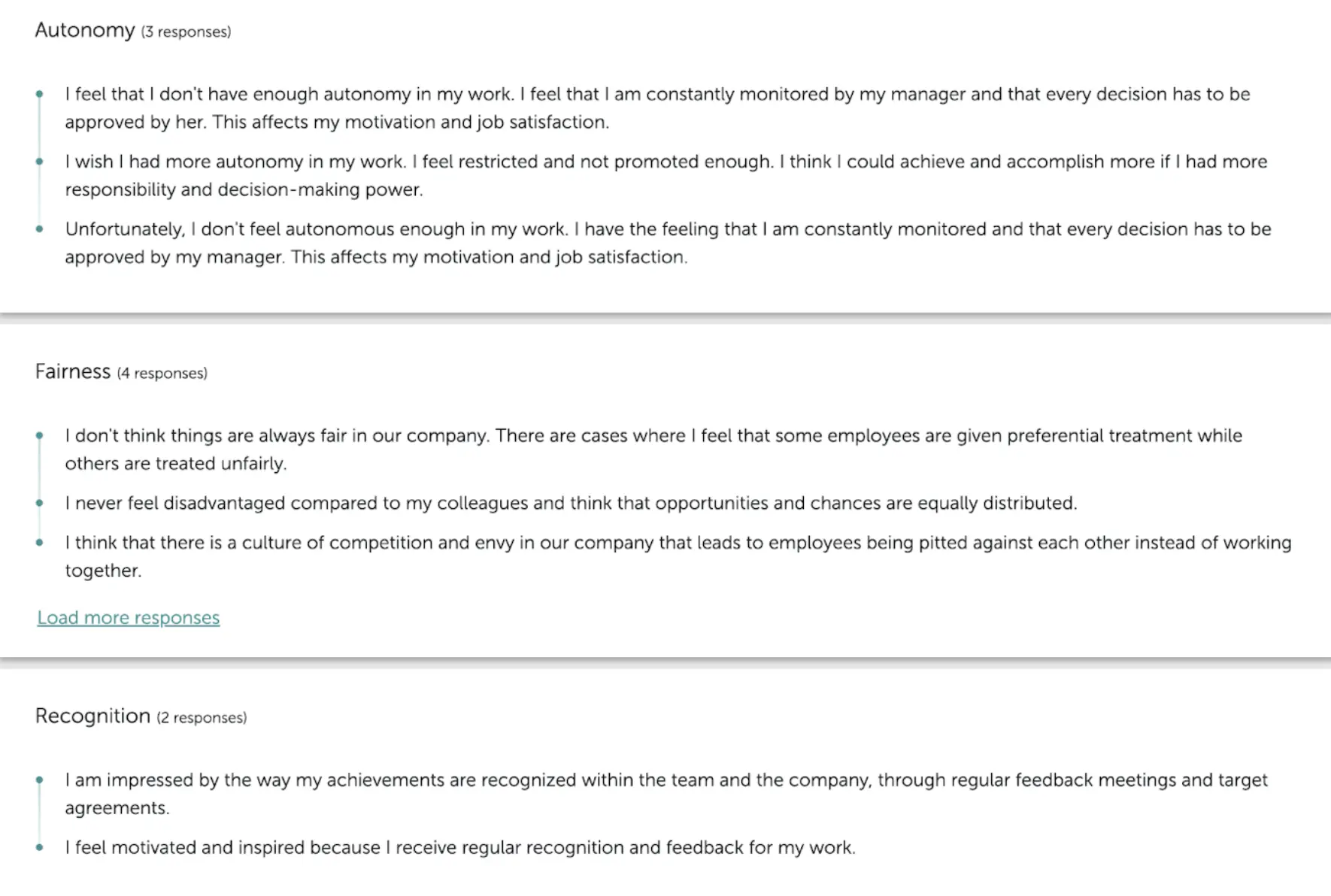
Step 4: Plan Your Survey Distribution
At this stage, your main goal is to generate maximum participation and gather meaningful data.
First, select the right time to share the survey. Avoid busy periods such as the end of the financial year or major project deadlines.
Next, explain why you’re conducting the survey—and why it’s important. Emphasize how this feedback will help you make tangible improvements in the workplace.
For example, if you’re researching work-life balance, explain that these insights could lead to adjustments in flexible working policies or the introduction of new wellness programs.
It’s also important to create an optimal distribution process. Here’s how:
1. Conduct a pilot test: Before rolling out the survey to the entire organization, select a diverse group of employees to participate in a pilot test.
It’s also a good idea to collect feedback from these people. This helps identify any confusing questions or technical issues with the survey platform.
2. Use various platforms: Share the survey across different channels (e.g., email, Slack, mentions during company syncs) and personalize your communications. For example:

3. Set a response deadline: Define a specific deadline to encourage timely participation—while giving your workers enough time to respond.
4. Incentivize participation: While not always necessary, offering incentives (e.g., entry into a raffle for completed surveys) can boost participation rates.
Step 4: Analyze the Survey Results and Act on Them
Finally, the real work begins: turning insights into impactful changes.
Sift through the survey responses and look for patterns and important trends.
Go beyond the surface: Segment and compare your data.
Are there any outliers across departments, teams, locations, and positions? Finding such patterns can be extremely useful.
For example, you could discover that one team experimented with changes that positively impact employee satisfaction—and introduce this change in other departments.
Or, you might see that some locations need better office premises.
Use Honestly’s heatmaps to automate this step. The tool will quickly spot and present all important insights you might overlook otherwise.
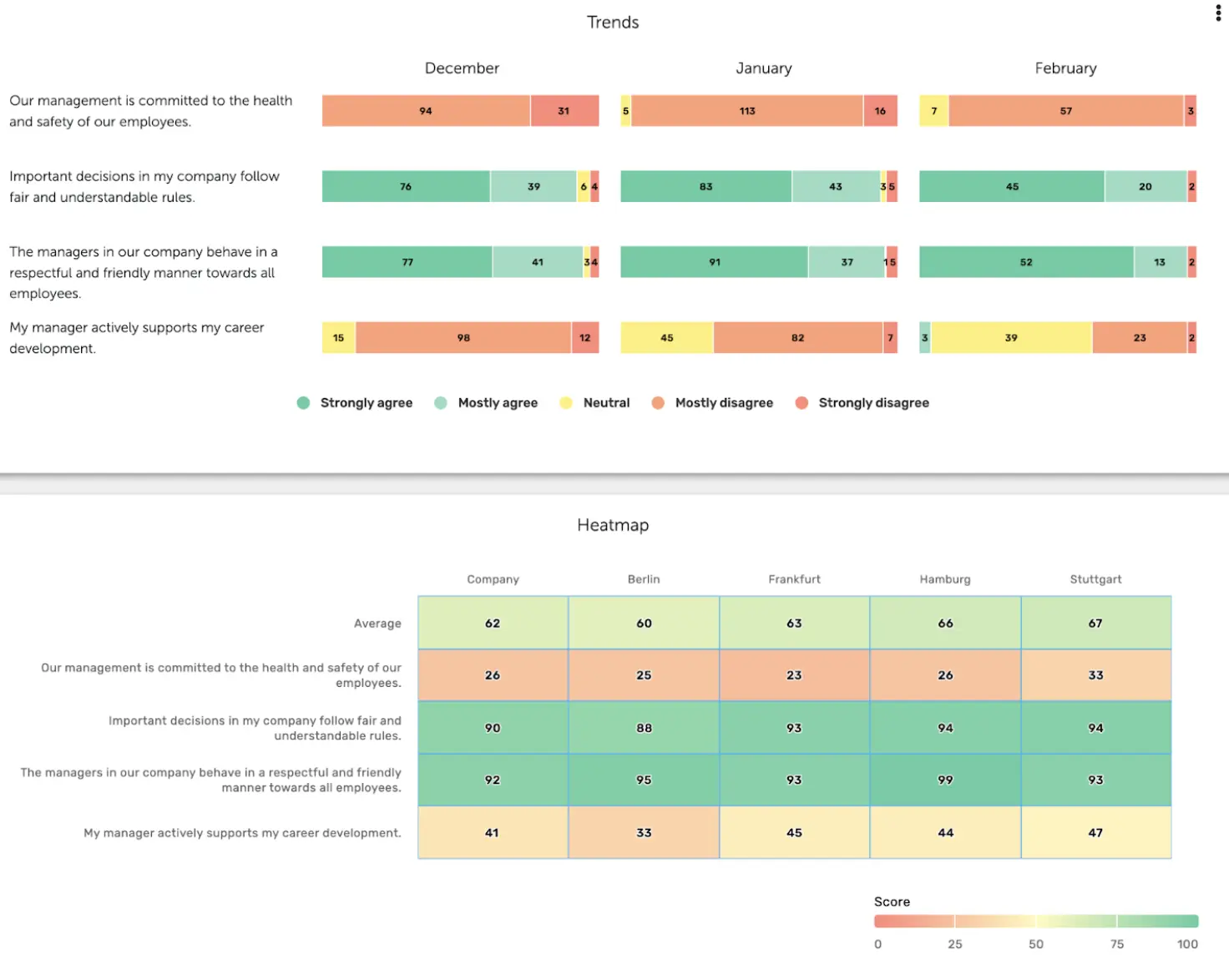
Finally, make sure to close the loop with your employees.
Share what you’ve learned from the survey and, more importantly, what you plan to do about it.
This step is crucial for building trust and showing your team that their voices lead to real change.
As you roll out these changes, keep the communication lines open and plan a follow-up survey.
Were the changes you introduced successful? Do you need to add further fixes? The survey will show.
Tips for Conducting Employee Satisfaction Surveys
Here are a few tips to make your employee satisfaction surveys effective and actionable.
Align Survey Questions with Actionable Goals
Before launching your survey, clarify your objectives and only focus on areas where you can (and will) drive change.
It’s crucial to ask about issues where feedback can lead to real improvements.
This approach streamlines your efforts and demonstrates to your employees that they can impact bigger things in their company.
Secure Management Support
Getting buy-in from management is essential to achieve high survey participation.
When leaders actively underscore the survey’s importance, it signals to employees that their feedback will be taken seriously.
For example, encourage managers to highlight the survey’s importance in team meetings, emphasizing how feedback will shape workplace improvements.
Integrate Survey Insights with Performance Data
For a deeper dive, mix the feedback from your surveys with actual performance numbers.
Seeing how satisfaction and work results line up shows you what really matters for your team’s happiness and success.
For example, you might discover that departments with high scores in “recognition for work” also show quicker project turnaround times.
This suggests that acknowledging employees’ efforts could be a key driver in speeding up project completion.
Conduct Regular Satisfaction Surveys
Consistency is key.
Make sure to launch employee satisfaction surveys regularly—be it annually, bi-annually, or quarterly.
It’ll help you track progress over time and keep a pulse on employee sentiment.
Free Employee Satisfaction Survey Template
Grab our free Employee Satisfaction Survey Template to save time and dive straight into collecting valuable insights.
It offers a solid starting point for understanding your team’s needs and creating a fulfilling work environment.
FAQs
How do you structure an employee satisfaction survey?
Structuring an employee satisfaction survey starts with a clear, easy-to-follow layout.
Begin with broad questions about overall job satisfaction, then move into specific areas like work environment, team dynamics, and personal growth.
You can mix question types (e.g., multiple-choice, scale ratings, open-ended) to keep your survey engaging and gather varied insights. But, it’s still important to maintain consistency in the question types.
Finally, finish your survey with an open-ended question to let your employees share their thoughts. For example:

How many questions should an employee satisfaction survey have?
The number of questions in an employee satisfaction survey depends on several factors— including the survey’s scope, the topics covered, and the level of detail you’re looking for.
Try to strike a balance, keeping the survey both comprehensive and concise.
Ideally, your survey should not require longer than 10-15 minutes to complete.
What’s a good employee satisfaction score?
A good employee satisfaction score generally sits above the industry average.
But, aiming for the 70-80% range is a solid target for most organizations. This score demonstrates a healthy level of happiness in your team.
Remember, though, the goal isn’t just to hit a number—but to understand the story behind the scores.
How to present employee satisfaction survey results?
Organize a team meeting or a video call to share the results of your employee satisfaction survey.
Talk about what you discovered, what needs improvement, and what steps you’ll take next. Creating simple slides or charts will help you clarify the message.
Finish with a Q&A to answer any questions. You can also share a summary via email and messengers for those who didn’t make it to the meeting.
What initiatives to launch after conducting an employee satisfaction survey?
Your next steps will depend on your initial goals and the insights you gathered.
For example, if the survey highlights a need for better communication, consider planning team-building activities.
Facing issues with work-life balance? Then, flex-time or remote work options might be the answer.
Aligning your actions with specific insights helps you address issues that truly matter to your team.
Boost Productivity with Higher Employee Satisfaction
Let’s keep it simple: Employee satisfaction surveys are your secret to building a happier team.
Use the feedback you collect to make real changes where they’re needed when they’re needed.
Honestly has got your back with powerful tools that make this easy.
So, dive in, listen closely, and watch your workplace transform.

